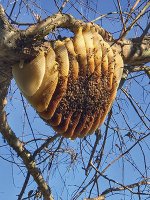SLOVENIA LOVES BEES!
Last May I went on a tour of Slovenia to visit beekeepers and learn about beekeeping practices there. We were there during the first World Bee Day (which was proposed by Slovenia to the United Nations) and the dedication of the Carniolan bee monument. In my opinion, Slovenia’s love of honey bees is unsurpassed by any other country and is shown in so many ways. I wrote an article for a local bee supply company’s e-Newsletter giving ten reasons why Slovenia should be the honey bee capital of the world. If any of your readers are interested, they can access it at https://baileybeesupply.com/educational_resources/ under “Randall’s Archives” for January 2019. I think they will be as amazed as I was. The ABJ has published several articles over the years about beekeeping in Slovenia. I have referenced these at the end of my article in case anyone wants more information. Thanks for helping to spread the word about this bee-loving country.
Suzy Spencer
Raleigh, NC
You are welcome, Suzy. You mention in your article that you are Slovenian on your mother’s side. I am also half Slovenian, but on my father’s side as the name might suggest. My grandfather kept bees there before emigrating to this country, so I am intrigued by that country’s love of beekeeping. Thanks for sharing.
Eugene
 OPEN AIR HIVE
OPEN AIR HIVE
Howdy American Bee Journal,
I took this photo of an open air hive I rescued in December in Texas. It was a real beauty. Found the queen in the 3rd sleeve of comb. Bees are safe and sound inside a new box with plenty of honey stores and drawn comb. Feel free to use if you want. I love your magazine … the best!!!
Take care!
Stan “da Bee Man” Gore
Texas Honey Bee Rescue
HONEY, OR HONEYDEW?
Hi Eugene
In your January 2019 ABJ issue, in The Classroom by Jerry, one beekeeper from Boise, Idaho asked why his honey did not granulate from 1994. The answer is, he collected HONEYDEW! It is dark in color and never crystallizes.
Senad Livadic
Beekeeper from Bosnia and Michigan
Jerry Hayes responds:
If it was, in fact, honeydew ‘honey’, sometimes called Forest Honey, it is actually aphid poop. As aphids feed on the sap of some trees, they excrete the excess which can have a high enough sugar content to attract ‘bees.’ It does resist crystallization because generally it has a higher fructose level and lower glucose level which balances, and the honey does not try to form crystals to rebalance the ratio.
But, getting that volume of honeydew Forest ‘honey’ does not happen in the U.S. very often as it does in some parts of Germany, which is well known for it.
And the question is, if honey is produced from flower nectar then anything thing else which the bees might collect like this aphid excretion would not be honey.
I have honey from decades ago as well that has not crystallized, simply because the sugar ratios were balanced from the time of collection of the nectar as well.
Thank you for your comments. I appreciate them.
Jerry
“THE BIG PICTURE” IS NOT SO PRETTY
Dear Mr. Makovec,
I have never written a letter like this before and now at 72 years of age with 43 years of beekeeping behind me, I would like to thank the editors of the ABJ for all of the inspiring articles over the years. This includes the January 2019 issue with the new editor at the helm. I look forward to each and every issue.
However, there is an article in the January issue that I question why it was published. “Modern Farm Myths” contains some important truths such as understanding and appreciating the landowner upon whose land our bee yards are located. But to say that crop acres are decreasing and habitat is increasing at a million acres per year makes me wonder what world Mr. Linder is living in. USDA statistics show that between 1970 and 2018 corn and soybean acres have gone from 114 million acres to 197 million acres! That is an 83-million-acre increase.
Mr. Linder wrote that we need to look at “The Big Picture.” He is exactly right. But that picture needs to include an awareness of where we are going. As a boy growing up in the 1950s and ‘60s on a farm with dairy cows, hogs, and chickens, I spent countless days on the tractor cultivating corn because my father did not want to contaminate the ground water with Atrazine. My free time was spent hunting and fishing. In early summer we heard the whistle of the ….


 OPEN AIR HIVE
OPEN AIR HIVE